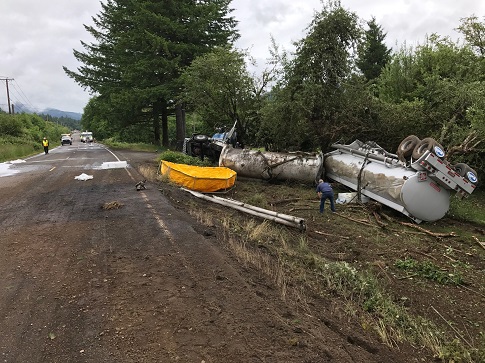Related News
Related News
-
Let's Talk Turkey. Is your family ready for winter?
We're heading into the holidays, but that also means snow, ice, and not-so-nice weather might be in the forecast. Here are some tips to prepare in advance.
Find Out More -
EWEB Hosts Annual Spill Drill to Protect McKenzie River
EWEB led emergency responders in its annual “spill drill” on the McKenzie River on Wednesday, Oct. 15, at the Trail Bridge Campground.
Find Out More -
A day in the life: Monitoring water quality throughout the McKenzie Watershed
Follow Senior Environmental Specialist David Donahue as he collects water quality samples from throughout the watershed as part of EWEB's early warning system for threats to Eugene's drinking water.
Find Out More -
EWEB Partners with Eugene School District 4J to Celebrate New Kennedy Middle School Emergency Water Station Site
Hundreds of attendees practiced filling up water containers at Saturday's demonstration event.
Find Out More -
Electric Projects underway in North & South Eugene
Underground lines and disaster-resilient power poles are part of EWEB’s infrastructure upgrade near Eugene’s largest natural resource area.
Find Out More -
Quartz Creek: Setting the Stage for Floodplain Restoration
The project resets the floodplain along 1.8 miles of a formerly channelized creek to improve water quality, fish habitat and natural disaster resiliency.
Find Out More -
Pure Water Partners: 5 Years of Regeneration
As EWEB and the Pure Water Partners observe the fifth anniversary of the Holiday Farm Fire, we celebrate major milestones in the watershed's recovery and check back in with PWP landowners who still have a lot of work ahead as they continue to rebuild their lives.
Find Out More -
Join the Pledge to Prepare
When you think about getting ready for an emergency, you probably have questions. You aren't alone. Preparing for emergencies can be overwhelming, which is why EWEB has put together a 12-month program to help you and your family get two weeks ready.
Find Out More -
You can’t predict the next disaster, but you can prepare
The earthquake lasted less than a minute. But now the power’s out. The tap runs dry. Cell service is spotty. Would you be ready?
Find Out More -
EWEB Celebrates Operators on the 75th Anniversary of the Hayden Bridge Filtration Plant
Learn more about the Water Treatment Plant Operators who have kept the Hayden Bridge Filtration Plant running for the last 75 years.
Find Out More -
NASA partners with EWEB to assess wildfire impacts to drinking water
NASA's Earth Information Center shares a new video detailing how EWEB's Drinking Water Source Protection work is advising new research tools
Find Out More -
EWEB prepares for wildfire season with risk mitigation measures
EWEB is building a more resilient electric system to weather various types of disasters, from wildfire to winter storms.
Find Out More -
EWEB environmental specialist wins prestigious awards for publication
Article recounting EWEB’s efforts to protect the McKenzie River after Holiday Farm Fire earns national recognition
Find Out More -
Last Call for EWEB/Lane County Septic Grants
Holiday Farm Fire recovery program now eligible for businesses, residential property owners who purchased post-fire, to cover inspection costs and new construction
Find Out More -
EWEB Pilots New Line Safety Program for 4th graders.
This year, EWEB is ramping up power line safety for children, specifically 4th graders.
Find Out More - Show More
Tanker Crash Highlights Importance of Emergency Preparedness and Response Efforts
June 14, 2017

A fuel tanker was carrying approximately 11,000 gallons of gasoline when it crashed along the McKenzie Highway one mile east of Leaburg on June 13, 2017. When emergency crews arrived on the scene, the tanker and trailer were found leaking and fuel was on the roadway.
The crash occurred just 1,500 feet from the McKenzie River, the sole source of drinking water for 200,000 people in Eugene and surrounding areas. The McKenzie also provides critical habitat for a number of endangered or threatened species including spring Chinook salmon, bull trout, spotted owl, Oregon chub, osprey and western pond turtle.
Fortunately, the spilled fuel did not enter into any tributaries of the McKenzie River, or the river itself. There was no surface water connecting the crash site to the waterways. However, the tanker released approximately 1,700 gallons of gasoline, contaminating soil and potentially impacting ground water. The initial response was carried out by McKenzie Fire & Rescue, Eugene-Springfield Fire Department's Hazardous Materials Team and Oregon Department of Transportation, until hazardous materials spill contractors and the Oregon Department of Environmental Quality were able to take over the clean-up effort, which is expected to last for several days.
Emergency response is an integral part of our drinking water source protection program
For more than 17 years, we have maintained an ambitious drinking water source protection program to protect the McKenzie and maintain the high water quality you enjoy. A critical component of the program is watershed emergency response.
While there are a number of potential hazards that could impact our water supply, chemical spills from transportation accidents is one of the highest threats to the McKenzie watershed. Hundreds of trucks travel the McKenzie Highway every day, many of them carrying hazardous materials such as gasoline, pesticides, and oil.
We want to be proactive in responding to a hazardous spill or other emergencies that could threaten McKenzie River water quality, so we have worked with dozens of federal, state and local agencies to implement the McKenzie Watershed Emergency Response System (MWERS). Incident commanders use MWERS to quickly gain access to crucial information, equipment and trained people, making their response more effective.
"A reoccurring theme associated with major spills or releases is that there is confusion and uncertainty for first responders in the initial 6 to 12 hours following an event, and it is during those early hours when the opportunity to contain the spill may still exist," says EWEB's environmental supervisor Karl Morgenstern. "The McKenzie Watershed Emergency Response System provides first responders with the tools they need to avoid confusion and effectively stabilize chemical spills as quickly as possible."
EWEB and dozens of partner agencies conduct annual MWERS training exercises to help prepare for chemical spills and other events that could impact the McKenzie watershed and our community's drinking water. As a result of conducting annual interagency emergency response drills on the river, EWEB was notified within minutes of the crash and worked closely with initial responders familiar with each other. Additional resources were offered if needed from the Army Corps of Engineers, City of Springfield, Springfield Utility Board and others who are part of MWERS.
We're investing in long-term reliability of our drinking water system
In additional to chemical spills, a number of other emergencies could result in a water supply shortage: earthquake, drought, forest fire, severe flood, or a system or facility failure.
In case of an emergency our community is going to need access to clean water for drinking, public health and safety, so we're making strategic investments in key components of the water system. Our Water Reliability Initiative includes several infrastructure reliability projects over the next 10 years, including replacing water mains, upgrading interties, upgrading or building new reservoirs, adding back-up electrical power to pump stations, expanding the Hayden Bridge Filtration Plant and developing alternative water sources.
We also are working in partnership with neighboring water utilities, local public agencies, the Oregon Pacific Chapter of the American Red Cross and other emergency responders to assure a well-coordinated disaster response effort.
Emergency preparedness is a shared responsibility
We are taking steps to prepare for an emergency in our community, whether human-caused or a natural disaster. You can do your part by building an emergency supply kit for your household.
If a natural or man-made disaster occurs, you can rest easier knowing you are better prepared with a household emergency kit. Putting together your own kit is simple and easy, and it begins with having on hand a minimum of one gallon of water per person per day for drinking and basic sanitation. While the American Red Cross recommends storing at least a three-day supply of water, larger disasters such as a possible Cascadia Subduction Zone earthquake may require water for 14 days or more.
Learn more about building an emergency kit and where to get water during an emergency.

